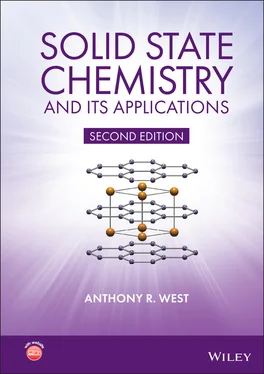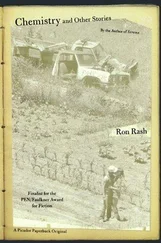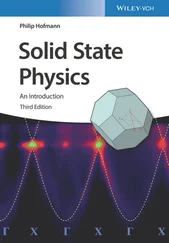1 ...8 9 10 12 13 14 ...55 A curious fact is that, in the early days of chemistry, inorganic chemistry had as its main focus, the elements of the periodic table and their naturally occurring or easy‐to‐make compounds such as oxides and halides. Inorganic chemistry subsequently diversified to include organometallic chemistry and coordination chemistry but interestingly, many traditional inorganic materials have returned to centre‐stage and are now at the heart of solid state materials science. Examples include: Cr‐doped Al 2O 3for lasers; doped Si semiconductors for microelectronics; doped ZrO 2as the solid electrolyte in solid oxide fuel cells; BaTiO 3as the basis of the capacitor industry with a total annual production worldwide exceeding 10 12units; copper oxide‐based materials for superconductor applications; and many, many more. The scope for developing new solid state materials/applications is infinite, judging by the ‘simple’ example of Al 2O 3described above. Most such materials tend not to suffer from problems such as volatilisation, degradation and atmospheric attack, which are often a drawback of molecular materials, and can be used safely in the environment.
It is important to recognise also that physical properties of inorganic solids often depend on structure at different length scales, as shown by the following examples:

Thus, in the case of ruby, which is a natural gemstone and was the first material in which LASER action – light amplification by stimulated emission of radiation – was demonstrated, two structural aspects are important. One is the host crystal structure of corundum, α ‐Al 2O 3and the other is the Cr 3+dopant which substitutes at random for about 1% of the Al 3+ions in the corundum lattice: the Cr–O bond lengths and the octahedral site symmetry are controlled by the host structure; the two together combine to give the red ruby colour by means of d – d transitions within the Cr chromophore and the possibility of accessing the long‐lived excited states that are necessary for LASER action.
A remarkable example of the effect of crystal structure details at the unit cell scale on properties is shown by dicalcium silicate, Ca 2SiO 4which is readily prepared in two polymorphic forms at room temperature. One, the β ‐polymorph, reacts with water to give a semicrystalline calcium silicate hydrate which sets rock‐solid and is a main constituent of concrete; the other polymorph, γ ‐Ca 2SiO 4, does not react with water. Just think, the entire construction industry rests on the detailed polymorphism of dicalcium silicate! It is not sufficient that one of the key components of cement has the right composition, Ca 2SiO 4; in addition, the precise manner in which ions are packed together in the solid state is critical to its hydration properties and whether or not it turns into concrete.
At the nanoscale, crystalline particles may contain many hundreds of unit cells but often their properties are different from powders, ceramics or single crystals of the same material with larger‐sized grains simply because of the influence of surface energies. In small nanoparticles, surface free energies and structures increasingly dominate the total free energy of a material, as shown by the colour, and associated band gap, of CdS nanoparticles (or colloids in older terminology) which can be fine‐tuned by controlling the particle size.
Some properties are determined by structure at the micron (1 μm = 10 3nm = 10 4Å = 10 −3mm) scale and this is the reason why ‘microstructure’ features strongly in the characterisation of metals and ceramics, primarily using optical and electron microscopy techniques. Frequently, impurities/dopants may precipitate at grain boundaries and surfaces and these can have a dramatic influence on for instance, the mechanical properties.
These examples illustrate the awesome challenges that must be met before an inorganic solid can be regarded as fully characterised across the length scales. This, coupled with the enormous number of inorganic crystal structures that are known, and the possibility to introduce dopants which modify properties, underlines why solid state chemistry is a central subject to many areas of physical science, engineering and technology.
The need to characterise solid state materials across the length scales from atomic through to macro is, however, part of a much bigger picture that includes the targeted synthesis of materials with different dimensionality and size. This takes us into the realms of nanomaterials and nanotechnology. Nanomaterials have reduced particle size and much increased net surface area, but also include many examples of low dimensionality, typified by the carbon nanostructures of zero‐dimensional fullerenes C60 and C70, one‐dimensional carbon nanotubes and two‐dimensional graphene sheets.
Physical properties of nanomaterials often diverge from those expected based on the known behaviour of macro‐sized and three‐dimensional materials. Thus, quantum confinement effects lead to band structure modification and variable electronic and optical properties in colloidal systems. The importance of surface structure and properties is increasingly dominant in nano‐sized materials because most of the material is close to, or at, a surface. Surface structures always differ from bulk structures because of modified coordination environments and bonding arrangements, but in the study of bulk materials, surface effects are frequently ignored in favour of the dominant bulk structure and properties. They cannot be ignored in nanomaterials however, because nano‐size local bonding/structure effects underpin industries that are often based on and include heterogeneous catalysis, sensors, smart windows and solar cell technology.
High quality chemical science thrives on well‐crystallised, homogeneous materials, whose structures, bonding and properties can be well‐understood, rationalised and integrated into a coherent overview of the subject. However, many materials properties and applications depend on heterogeneity, either through compositional gradients in doped materials or through the formation of composite structures. In such cases, emergent phenomena often arise in which the overall properties are not simply a sum of the component parts but have additional, value‐added characteristics. Examples include:
reversible semiconductor–insulator transitions on heating doped, inhomogeneous barium titanate ceramics, used as temperature controllers in for example, hair dryers.
voltage‐induced insulator–semiconductor transitions in lightning and voltage overload protection devices, based on doped zinc oxide. These two examples are the exact opposite of thermodynamically stable, well‐characterised homogeneous materials. Their study can lead to practical frustrations: if one attempts to prepare high quality, homogeneous materials in order to better understand their behaviour, then the key properties of interest may be lost!
it is becoming increasingly possible to design and fabricate entirely new materials which are kinetically stable but thermodynamically metastable or unstable, either by moving individual atoms in an electron microscope or depositing specific layers of atoms, one layer at a time, using techniques such as atomic layer or molecular beam epitaxy, ALD and MBE. A very eye‐catching example is the creation of so‐called electron gases at metallic interfaces in two‐dimensional structures consisting of alternating layers of the insulating oxides SrTiO3 and LaAlO3. Another consequence of reduction in size of nano‐structures is that they become increasingly disordered and lose their regular three‐dimensional periodicity. The local structure involving coordination numbers and bond lengths is usually retained but, depending on the length scale, they may be better regarded as amorphous. Glasses are traditionally made by the rapid cooling of liquids so as to avoid their crystallisation; amorphous nanomaterials may never pass through a high temperature, liquid state but nevertheless, show many of the characteristic properties of glasses.
Читать дальше













